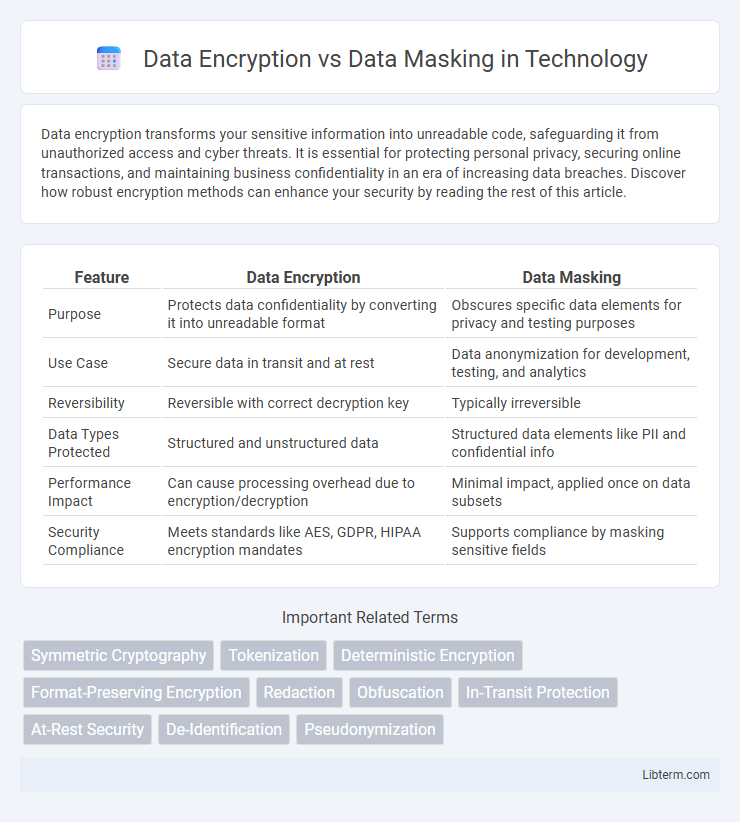Data encryption transforms your sensitive information into unreadable code, safeguarding it from unauthorized access and cyber threats. It is essential for protecting personal privacy, securing online transactions, and maintaining business confidentiality in an era of increasing data breaches. Discover how robust encryption methods can enhance your security by reading the rest of this article.
Table of Comparison
| Feature | Data Encryption | Data Masking |
|---|---|---|
| Purpose | Protects data confidentiality by converting it into unreadable format | Obscures specific data elements for privacy and testing purposes |
| Use Case | Secure data in transit and at rest | Data anonymization for development, testing, and analytics |
| Reversibility | Reversible with correct decryption key | Typically irreversible |
| Data Types Protected | Structured and unstructured data | Structured data elements like PII and confidential info |
| Performance Impact | Can cause processing overhead due to encryption/decryption | Minimal impact, applied once on data subsets |
| Security Compliance | Meets standards like AES, GDPR, HIPAA encryption mandates | Supports compliance by masking sensitive fields |
Introduction to Data Encryption and Data Masking
Data encryption converts sensitive information into a coded format using algorithms and keys, ensuring data confidentiality and protection against unauthorized access. Data masking replaces original data with realistic but fictional values, preserving data utility for testing or analysis while safeguarding privacy. Both techniques serve as critical tools in data security, addressing different aspects of data protection and compliance requirements.
Key Differences Between Data Encryption and Data Masking
Data encryption transforms sensitive information into unreadable ciphertext using algorithms and encryption keys, ensuring data confidentiality during storage or transmission. Data masking, however, replaces original data with fictitious but realistic values to protect sensitive information in non-production environments without altering the underlying data format. Key differences include encryption's reversibility through decryption, while masking is typically irreversible, and encryption secures data against unauthorized access, whereas masking focuses on data privacy for testing or development purposes.
How Data Encryption Works
Data encryption transforms readable data into an encoded format using algorithms and encryption keys, making it inaccessible without the correct decryption key. It relies on cryptographic techniques such as symmetric encryption, where the same key is used for both encryption and decryption, and asymmetric encryption, which uses a pair of public and private keys. This process ensures data confidentiality and integrity, protecting sensitive information from unauthorized access during storage or transmission.
How Data Masking Works
Data masking works by substituting sensitive information with fictitious yet realistic data, ensuring that the format and consistency remain intact while preventing unauthorized access to the original values. This process involves techniques like character substitution, shuffling, or encryption of data elements to create a protected version that can be used safely in non-secure environments such as development or testing. Unlike data encryption, which requires decryption to access original data, data masking provides a non-reversible transformation, maintaining data privacy without compromising usability.
Use Cases for Data Encryption
Data encryption secures sensitive information by converting it into unreadable ciphertext, making it essential for protecting data in transit and at rest within industries such as finance, healthcare, and e-commerce. Encryption is ideal for securing communications, safeguarding stored data on cloud services, and ensuring compliance with regulations like GDPR and HIPAA. This technique enables secure data sharing between authorized parties while maintaining confidentiality against unauthorized access.
Use Cases for Data Masking
Data masking is essential for protecting sensitive information in non-production environments such as software testing, user training, and data analysis, where exposure to real data could lead to security risks. It enables organizations to maintain data privacy compliance by creating realistic but fictitious data sets, reducing the risk of data breaches in development and QA processes. Unlike encryption, data masking ensures usability of data without the need for decryption keys, making it ideal for scenarios where data confidentiality must be preserved without compromising operational efficiency.
Security Benefits of Data Encryption
Data encryption provides robust security by converting plaintext into unreadable ciphertext, ensuring data confidentiality even if intercepted. Strong encryption algorithms like AES-256 protect sensitive information from unauthorized access and cyberattacks. Unlike data masking, encryption enables secure data storage and transmission while allowing authorized users to decrypt and access the original information.
Privacy Advantages of Data Masking
Data masking enhances privacy by replacing sensitive information with realistic but fictitious data, ensuring that unauthorized users access only obfuscated information without compromising the original dataset. Unlike data encryption, which requires decryption keys and can expose data during processing, data masking maintains privacy throughout the data lifecycle by providing permanent, non-reversible transformations for testing, development, and analytical purposes. This approach significantly reduces the risk of data breaches while complying with privacy regulations such as GDPR and HIPAA.
Choosing Between Data Encryption and Data Masking
Choosing between data encryption and data masking depends on the objective of data protection and usage context; encryption secures data by converting it into unreadable format for unauthorized users, ideal for data at rest or in transit requiring confidentiality. Data masking replaces sensitive data with fictitious but realistic values, allowing safe use in non-production environments like testing or training. Organizations must assess factors such as compliance requirements, data accessibility needs, and risk tolerance to determine the most effective approach for protecting sensitive information.
Future Trends in Data Protection Techniques
Future trends in data protection techniques emphasize the integration of advanced data encryption algorithms with AI-driven data masking solutions to enhance security and privacy. Homomorphic encryption and quantum-resistant cryptographic methods are emerging to address growing cyber threats, while dynamic data masking leverages machine learning for real-time sensitive data obfuscation. Organizations increasingly adopt hybrid approaches combining encryption and masking to comply with stringent regulations and safeguard evolving digital ecosystems.
Data Encryption Infographic

 libterm.com
libterm.com